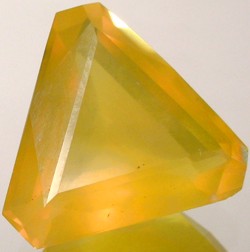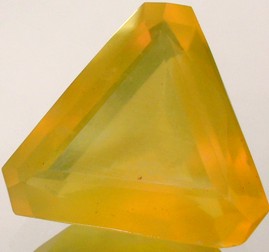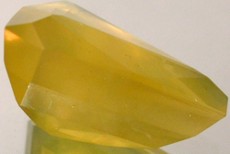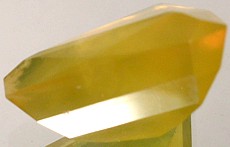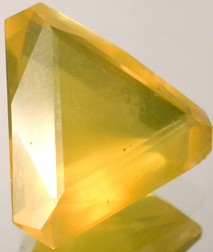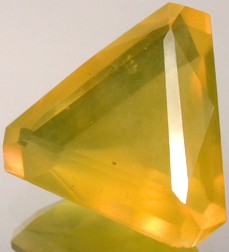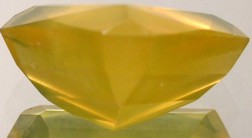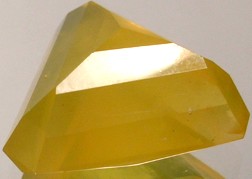|
For Customers outside of USA 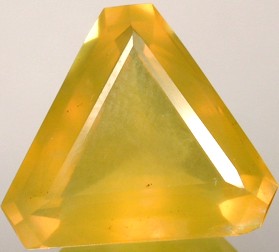
Antique Handcrafted Genuine Natural Four and Three-Quarter Carat Yellow Turkish Fire Opal Semi-Precious Gemstone. CLASSIFICATION: Yellow Fire Opal. ORIGIN: 19th Century Turkey. Cut and Faceted in 19th Century Russia. SIZE: 14 1/2mm to Each Side. Depth: 7mm. All measurements approximate. WEIGHT: 4.81 carats. NOTES: Upon request we can set your gemstone as a ring, earring, or pendant.
DETAIL: This is a rather uncommon semi-precious gemstone known as "fire opal". Mined in nineteenth century Turkey where it had been originally produced perhaps as early as 3,000 B.C., it went to one of the fabulous jewelry production centers of Czarist Russia. It was hand cut and faceted into this gorgeous gemstone for use in a piece of elaborate jewelry for which Renaissance and Victorian Russia was so renowned. The result is an exquisite and incredibly richly colored semi-precious gemstone with lots of depth and gorgeous tone. The color is a quite exquisite and rich yellow with orange undertones, especially as it catches the light. Though this specimen is not absolutely flawless, it is of very good quality. It is a bit fuzzy and cloudy, but this is the rule with fire opal, the common condition, not the exception.
Under magnification the gemstone shows the unmistakable characteristics of having been hand crafted. The coarseness of the 19th century finish is considered appealing to most gemstone collectors, and is not considered a detriment, or detract from the value of a gemstone. These characteristics are not only expected of hand-finished gemstones, most serious collectors consider such gemstones more desirable, possessed of greater character and uniqueness when compared to today's cookie-cutter mass-produced machine-faceted gemstones. Unlike today's computer controlled machine produced gemstones, the cut and finish of a gemstone such as this is the legacy of an artisan who lived two centuries ago.
This gemstone has great luster and color, and to the eye is clean, but it is not absolutely flawless, and it is as well somewhat cloudy, which is quite typical of fire opal. To the cursory view of the casual admirer the gemstone is seemingly without blemish. However magnified five times over as it is here, you can see slight blemishes within the stone. Of course the same may said about almost any natural gemstone. An absolutely flawless gemstone simply is not the rule in nature. Most absolutely flawless gemstones will upon close examination be revealed to be synthetic. You might also notice under magnification occasional irregularities in the cut and finish. Of course absolutely unblemished, perfect gemstones are the realm of laboratory-produced synthetics, not Mother Nature. Furthermore these characteristics are not only expected of hand-finished gemstones, you must also consider that two centuries ago the mining techniques even possible then, let alone in practice, did not allow the ultra deep mining operations which are so commonplace today.
Keep in mind two centuries ago mankind was more or less limited to surface deposits or near surface deposits of gemstones. Higher quality gemstones which today are routinely mined from beneath hundreds of meters, even kilometers beneath the earth's surface, were simply inaccessible then. For these reasons antique gemstones must be appreciated as antiques first, gemstones second. The relatively superlative quality of contemporary gemstones routinely mined from deep beneath the earth's surface today were simply not accessible two centuries ago, or at least, only rarely so. However for most, the unique nature and character of antique gemstones such as this more than makes up for miniscule blemishes and cutting imperfections which by and large, are only visible under high magnification.
HISTORY: Fire Opal was well known in the ancient world, particularly Ancient India and Ancient Persia, and is named for its brilliant red to orange body color which is partly due to iron oxide. Most fire opal today is mined either in Mexico or Brazil. But in centuries past, it was mined in Turkey, Central America, Ethiopia; and more recently in Australia, Canada and the USA. Fire opal is lighter weight than other opal varieties, and tends to have one body color and do not usually contain the flashes of light and color typical of other opals. Fire Opal is the only natural opal that is normally faceted, and can range in color from bright yellow through bright orange and into red-orange, and is more often than not slightly cloudy.
In ancient times opal was included among the noble gems and was ranked second only to emerald by the Romans, who sometimes referred to opal as the "cupid stone". The original ancient source of opal gemstones, known in Roman times, was in what is now East Slovakia. Early Arabs believed opals fell from the heavens in flashes of lightning that gave them their fiery play-of-color. Ancient Greeks, amongst many other ancient cultures, thought opals gave their owner the gift of prophecy and prevented diseases. The name "opal" is derived from the Latin "opallus", and from Sanskrit "upala", both of which translate to "precious stone". Opals are generally divided into two groups, white and black. Both share the similar appearance where a spectrum of colors can be seen in the depths of the stone. Black opal, with a body color from a dark gray to black, containing within the full play of iridescent colors, is the most valuable variety of all. White opal, with light body colors, and fire opal, characterized by yellow, orange, or red body color, are much more common.
SHIPPING OPTIONS: All purchases are backed by an unlimited guarantee of satisfaction and authenticity. If for any reason you are not entirely satisfied with your purchase, you may return it for a complete and immediate refund of your entire purchase price. Most of these antique gemstones were originally part of two collections, one originating in India principally composed of gemstones originally mined in India, Burma, Ceylon, and Siam, and then hand faceted in India. The addition of a second accumulation of antique gemstones originally mined in the Urals in the mid to late 19th century (including alexandrite) completed the collection. These gemstones as well were hand finished. The Urals have been one of the world's major sources of precious and semi-precious gemstones for many centuries. As well, additional specimens are occasionally acquired from other institutions and dealers in Eastern Europe and Asia. These antique gemstones are now in the United States and are available for immediate delivery. We ship inventory from the USA order fulfillment center near Seattle, Washington. Your purchase will ordinarily be shipping within 48 hours of payment. A certificate of authenticity is available upon request. We prefer your personal check or money order over any other form of payment - and we will ship immediately upon receipt of your check (no "holds"). We will accept PayPal payments. Please see our "ADDITIONAL TERMS OF SALE".
|
|---|
